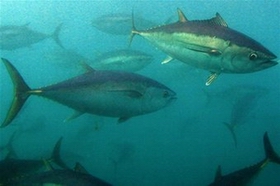 m the Secretariat of the Pacific Community shows that more than 2.6 million tonnes was caught in the central and western Pacific region last year.
m the Secretariat of the Pacific Community shows that more than 2.6 million tonnes was caught in the central and western Pacific region last year.That's 59 per cent of the global catch and 1200 tonnes more than the previous record, which was set in 2009.
The report's author, Dr Shelton Harley says 2012 was also a record year for industrial purse seine fishing, which was led by high prices of skipjack tuna.
"Five or six years ago, they were getting less than $500 a tonne for skipjack and now the price is up around $2000 a tonne and some of the profits some of these vessels are making are very high," he told Pacific Beat.
Concerns over sustainability
"So purse seining is a very lucrative business to be in at the moment and that is probably driving the increase in the vessels in the region," he said.
But the record numbers are of concern to conservationists, such as Greenpeace's Co-ordinator for International Sustainable Seafood Program, Cat Dorey.
She says more must be done to protect the fish species.
"We've already seen over at least the last eight years that big eye has been declining and if we don't get this under control, the stock will reach a level where it will struggle to maintain the population," she said.
Species such as big eye and yellow eye tuna which are already on the radar of scientists also recorded record catches in 2012, with yellow fin up 25 per cent.
Ms Dorey says there needs to be bigger cuts to fishing quotas, and will be pushing for that at the December meeting of the Central and Western Fisheries Commission in Cairns, Australia.
"We will certainly be calling for much more stronger cuts to fishing across all fleets, targeting these species, particularly the purse seine fleets that use fish aggregating devices because these are the ones that catch the high numbers of juvenile tuna", she said.







